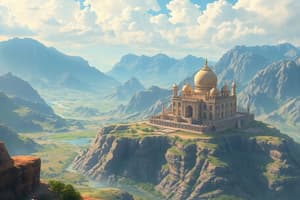Podcast
Questions and Answers
What are the major physical features of India?
What are the major physical features of India?
Mountains, plains, deserts, plateaus, and islands
Which region in India is described as having rugged terrain with mountains and valleys?
Which region in India is described as having rugged terrain with mountains and valleys?
Hilly region
What type of landmass is the Peninsular Plateau?
What type of landmass is the Peninsular Plateau?
One of the ancient landmasses on the earth’s surface
What geological characteristics do the Himalayas represent?
What geological characteristics do the Himalayas represent?
What are the northern plains of India formed of?
What are the northern plains of India formed of?
What type of rocks compose the peninsular plateau?
What type of rocks compose the peninsular plateau?
What is the width of the Himalayas in Arunachal Pradesh?
What is the width of the Himalayas in Arunachal Pradesh?
What is the average height of the loftiest peaks in the Great Himalayas?
What is the average height of the loftiest peaks in the Great Himalayas?
Name three prominent Himalayan peaks located in India.
Name three prominent Himalayan peaks located in India.
What is the composition of the core of the Great Himalayas?
What is the composition of the core of the Great Himalayas?
What is the altitude range of the Himachal or lesser Himalaya?
What is the altitude range of the Himachal or lesser Himalaya?
Name three prominent ranges forming the Himachal or lesser Himalaya.
Name three prominent ranges forming the Himachal or lesser Himalaya.
What is the altitude range of the Shiwaliks?
What is the altitude range of the Shiwaliks?
What is the average width of the Shiwaliks?
What is the average width of the Shiwaliks?
What are the names of three famous hill stations located in the region of the Himachal or lesser Himalaya?
What are the names of three famous hill stations located in the region of the Himachal or lesser Himalaya?
What is the distance covered by the Himalayan mountain ranges in an east-west direction?
What is the distance covered by the Himalayan mountain ranges in an east-west direction?
Flashcards are hidden until you start studying
Study Notes
Physical Features of India
- India's major physical features include the Himalayas, the Northern Plains, and the Peninsular Plateau.
Himalayas
- The Himalayas are a rugged terrain with mountains and valleys.
- The Himalayas represent a zone of intense mountain building activity, with geological characteristics of folding and faulting.
- The width of the Himalayas in Arunachal Pradesh is approximately 100 km.
- The loftiest peaks in the Great Himalayas have an average height of over 7,200 m.
Notable Himalayan Peaks
- Three prominent Himalayan peaks located in India are Nanda Devi, Kanchenjunga, and Mount Everest.
Composition of the Himalayas
- The core of the Great Himalayas is composed of granite rocks.
Himachal or Lesser Himalaya
- The altitude range of the Himachal or lesser Himalaya is between 1,500 to 5,000 m.
- Three prominent ranges forming the Himachal or lesser Himalaya are Dhaula Dhar, Pir Panjal, and Mahabharat.
Shiwaliks
- The altitude range of the Shiwaliks is between 900 to 1,500 m.
- The average width of the Shiwaliks is 10 to 50 km.
Hill Stations
- Three famous hill stations located in the region of the Himachal or lesser Himalaya are Shimla, Mussoorie, and Dharamshala.
Himalayan Mountain Ranges
- The Himalayan mountain ranges stretch for a distance of approximately 2,500 km in an east-west direction.
Studying That Suits You
Use AI to generate personalized quizzes and flashcards to suit your learning preferences.




